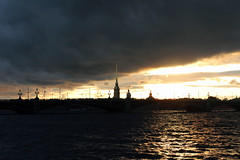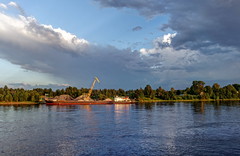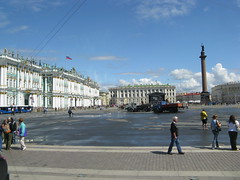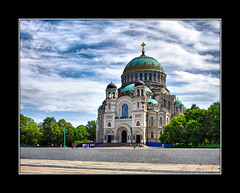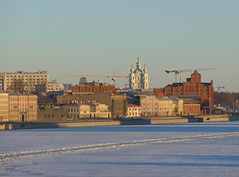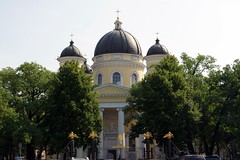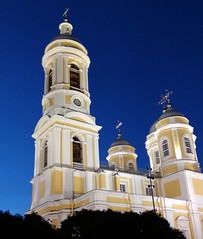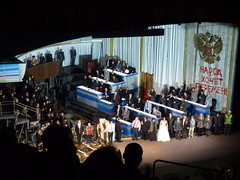Sankt-Peterburg
Saint Petersburg, formerly known as Petrograd (1914–1924) and later Leningrad (1924–1991), is the second-largest city in Russia. It is situated on the Neva River, at the head of the Gulf of Finland on the Baltic Sea. The city had a population of roughly 5.6 million residents as of 2021. Saint Petersburg is the fourth-most populous city in Europe, the most populous city on the Baltic Sea, and the world's northernmost city of more than 1 million residents. As Russia's Imperial capital, and a historically strategic port, it is governed as a federal city. The city was founded by Tsar Peter the Great on 27 May 1703 on the site of a captured Swedish fortress, and was named after apostle Saint Peter. In Russia, Saint Petersburg is historically and culturally associated with the birth of the Russian Empire and Russia's entry into modern history as a European great power. It served as a capital of the Tsardom of Russia, and the subsequent Russian Empire, from 1713 to 1918 (being replaced by Moscow for a short period of time between 1728 and 1730). After the October Revolution in 1917, the Bolsheviks moved their government to Moscow. The city was renamed Leningrad after Lenin's death in 1924. In a wave of De-Leninization following the dissolution of the USSR, the city was restored to is original appellation.
As Russia's cultural center, Saint Petersburg received over 15 million tourists in 2018. It is considered an important economic, scientific, and tourism centre of Russia and Europe. In modern times, the city has the nickname of being "the Northern Capital of Russia" and is home to notable federal government bodies such as the Constitutional Court of Russia and the Heraldic Council of the President of the Russian Federation. It is also a seat for the National Library of Russia and a planned location for the Supreme Court of Russia, as well as the home to the headquarters of the Russian Navy, and the Western Military District of the Russian Armed Forces. The Historic Centre of Saint Petersburg and Related Groups of Monuments constitute a UNESCO World Heritage Site. Saint Petersburg is home to the Hermitage, one of the largest art museums in the world, the Lakhta Center, the tallest skyscraper in Europe, and was one of the host cities of the 2018 FIFA World Cup and the UEFA Euro 2020.
Toponymy
The name day of Peter I falls on 29 June,when the Russian Orthodox Church observes the memory of apostles Peter and Paul. The consecration of the small wooden church in their names (its construction began at the same time as the citadel) made them the heavenly patrons of the Peter and Paul Fortress, while Saint Peter at the same time became the eponym of the whole city. When in June 1703 Peter the Great gave the site a new name after Saint Peter, he did not issue a naming act that established an official spelling; even in his own letters he used diverse spellings, such as Санктьпетерсьбурк (Sanktpetersburk), emulating German Sankt Petersburg, and Сантпитербурх (Santpiterburkh), emulating Dutch Sint-Pietersburgh, as Peter was multilingual and a Neerlandophile. The name was later normalized and russified to Санкт-Петербург.
A proponent of westernising Russia, Peter the Great, the then Tsar, who established the city, originally named it in Dutch manner and later its spelling was standardised as Sankt-Peterburg under German influence.
A former spelling of the city's name in English was Saint Petersburgh, under the influence of burgh. This spelling survives in the name of a street in the Bayswater district of London, near St Sophia's Cathedral, named after a visit by the Tsar to London in 1814.
A 14- to 15-letter-long name, composed of the three roots, proved too cumbersome, and many shortened versions were used. The first General Governor of the city Menshikov is maybe also the author of the first nickname of Petersburg which he called Петри (Petri). It took some years until the known Russian spelling of this name finally settled. In 1740s Mikhail Lomonosov uses a derivative of Greek: Πετρόπολις (Петрополис, Petropolis) in a Russified form Petropol (Петрополь). A combo Piterpol (Питерпол) also appears at this time. In any case, eventually the usage of prefix "Sankt-" ceased except for the formal official documents, where a three-letter abbreviation "СПб" (SPB) was very widely used as well.
In the 1830s Alexander Pushkin translated the "foreign" city name of "Saint Petersburg" to the more Russian Petrograd (Russian: Петроград) in one of his poems. However, it was only on , after the war with Germany had begun, that Tsar Nicholas II renamed the city Petrograd in order to expunge the German words and . Since the prefix "Saint" was omitted, this act also changed the eponym and the "patron" of the city from Saint Peter to Peter the Great, its founder. On 26 January 1924, shortly after the death of Vladimir Lenin, it was renamed to Leningrad (Russian: Ленинград), meaning 'Lenin's City'. On 6 September 1991, the original name, Sankt-Peterburg, was returned by citywide referendum. Today, in English the city is known as Saint Petersburg. Local residents often refer to the city by its shortened nickname, Piter (Russian: Питер).
After the October Revolution the name Red Petrograd (Красный Петроград, Krasny Petrograd) was often used in newspapers and other prints until the city was renamed Leningrad in January 1924.
A referendum on reversing the renaming of Leningrad was held on 12 June 1991, with 54.86% of voters (with a turnout of 65%) supporting "Saint Petersburg". Renaming the city Petrograd was not an option. This change officially took effect on 6 September 1991. Meanwhile, the oblast whose administrative center is also in Saint Petersburg is still named Leningrad.
Having passed the role of capital to Petersburg, Moscow never relinquished the title of "capital", being called pervoprestolnaya ('first-throned') for 200 years. An equivalent name for Petersburg, the "Northern Capital", has re-entered usage today since several federal institutions were recently moved from Moscow to Saint Petersburg. Solemn descriptive names like "the city of three revolutions" and "the cradle of the October revolution" used in the Soviet era are reminders of the pivotal events in national history that occurred here. Petropolis is a translation of a city name to Greek, and is also a kind of descriptive name: is a Greek root for 'stone', so the "city from stone" emphasizes the material that had been forcibly made obligatory for construction from the first years of the city. (The proper Greek translation is Αγία Πετρούπολη, Agia Petroupoli)
Saint Petersburg has been traditionally called the "Window to Europe" and the "Window to the West" by the Russians. The city is the northernmost metropolis in the world, and is also often described as the "Venice of the North" or the "Russian Venice" due to its many water corridors, as the city is built on swamp and water. Furthermore, it has strongly Western European-inspired architecture and culture, which is combined with the city's Russian heritage. Another nickname of Saint Petersburg is "The City of the White Nights" because of a natural phenomenon which arises due to the closeness to the polar region and ensures that in summer the night skies of the city do not get completely dark for a month. The city is also often called the "Northern Palmyra", due to its extravagant architecture.
History
Imperial era (1703–1917)
Swedish colonists built Nyenskans, a fortress at the mouth of the Neva River in 1611, which was later called Ingermanland. This area was inhabited by a Finnic tribe of Ingrians. The small town of Nyen grew up around the fort.
At the end of the 17th century, Peter the Great, who was interested in seafaring and maritime affairs, wanted Russia to gain a seaport to trade with the rest of Europe. He needed a better seaport than the country's main one at the time, Arkhangelsk, which was on the White Sea in the far north and closed to shipping during the winter.
On , during the Great Northern War, Peter the Great captured Nyenskans and soon replaced the fortress. On , closer to the estuary (inland from the gulf), on Zayachy (Hare) Island, he laid down the Peter and Paul Fortress, which became the first brick and stone building of the new city.
The city was built by conscripted peasants from all over Russia; in some years several Swedish prisoners of war were also involved under the supervision of Alexander Menshikov. Tens of thousands of serfs died while building the city. Later, the city became the centre of the Saint Petersburg Governorate. Peter moved the capital from Moscow to Saint Petersburg in 1712, 9 years before the Treaty of Nystad of 1721 ended the war. He referred to Saint Petersburg as the capital (or seat of government) as early as 1704. While the city was being built, Peter lived in a three-room log cabin with his wife Catherine and their children.
During its first few years, the city developed around Trinity Square on the right bank of the Neva, near the Peter and Paul Fortress. However, Saint Petersburg soon started to be built out according to a plan. By 1716 the Swiss Italian Domenico Trezzini had elaborated a project whereby the city centre would be on Vasilyevsky Island and shaped by a rectangular grid of canals. The project was not completed but is evident in the layout of the streets. In 1716, Peter the Great appointed Frenchman Jean-Baptiste Alexandre Le Blond as the chief architect of Saint Petersburg.
The style of Petrine Baroque, developed by Trezzini and other architects and exemplified by such buildings as the Menshikov Palace, Kunstkamera, Peter and Paul Cathedral, Twelve Collegia, became prominent in the city architecture of the early 18th century. In 1724 the Academy of Sciences, University and Academic Gymnasium were established in Saint Petersburg by Peter the Great.
In 1725, Peter died at age fifty-two. His endeavors to modernize Russia had…
Looking for places related to Sankt-Peterburg?
Those are other destinations to find places related to Sankt-Peterburg:


